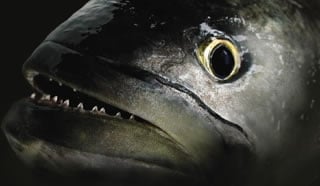
| Peanut buster: Bluefish love peanuts, and aren’t shy about hitting plugs and flies during a full-on bunker blitz. |
One sultry afternoon early last August, Al Buchman and I headed south into Long Island Sound. We had left the launch in Branford, Connecticut, knowing we were in for red-hot fishing about a mile off the coast. Oddly enough, we weren’t sure what we would catch. At that time of year, southern New England’s sure-bet species were on summer hiatus. Our fabulous spring run of big striped bass was over, blackfish had moved out, fluking was spotty and the fall invasion of slammer bluefish and false albacore wouldn’t begin until early September. But we knew one thing: when we found one of the numerous schools of tiny baitfish that dotted the nearshore waters, we would find some kind of predator feeding on them.
“I see birds!” I said as we skimmed over glassy seas. “Better get ready!”
“I’m all over it,” Al said, lifting a rod from the holder.
When we neared the frenzy, I stopped just upcurrent of the breaking fish and cut the motor. We both quickly free-spooled small diamond jigs toward the bottom, but neither lure made it that far.
“Got one!” Al called over the sound of slapping baitfish. “I had three hits on the way down.”
“I’m on too,” I said as I leaned back and set the hook. “This is great!”
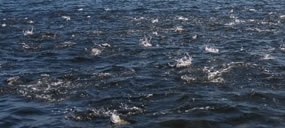
A school of bunker breaks the surface in an attempt to escape certain death from below. |
And it was great. We were drifting across a quarter-acre pod of medium bluefish that were gorging on immature menhaden. Almost every drop of the jig brought a vicious strike. And the best was yet to come.
The Peanut Bunker Story
From Maine to Florida, adult menhaden, or “bunker,” are one of the premier forage species for many game fish. Unfortunately, they are also highly sought by commercial fishing fleets, which process them into oil, fertilizer and fishmeal. As a result, schools of large menhaden have dropped to an all-time low. But young-of-the-year menhaden, commonly called “peanut bunker,” are not harvested commercially and have been plentiful off our shores in recent summers.
“Starting in late July,” says Captain Pete Rowney, a charter skipper who works the waters off Rhode Island and lower Cape Cod, “juvenile menhaden congregate in dense schools as they leave shallow estuaries for more open water. These ‘peanuts’ initially average about an inch long and fall prey to almost everything that swims off our shores. Because they are a major food source and one that is easily imitated by a variety of artificials, it makes them a key bait for anglers to imitate.”
Peanuts Mean Success
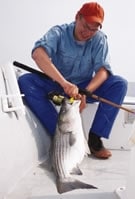
Jigging a soft-plastic bait below the surface activity can draw strikes from large stripers, which often wait to pick off scraps from the carnage above.|
A concentration of peanuts usually guarantees action during the dog days of summer, and there are several ways to find them. One is to look for them being chased across the surface by predators. Panicked peanuts push from the water in silver sheets that sound like small waves washing up on a beach. And, of course, the melee draws frenzied birds that can be seen from a distance. On the other hand, locating peanuts that are holding below the surface is much more difficult, so you need to know where and how to look for them.
“Juvenile menhaden are often found at the confluence of estuaries,” notes Captain Ned Kittredge, who charters off southern Massachusetts. “River mouths are always good places to search. Other promising areas are the usual predatory fish-finding spots, such as bays, drop-offs and rips. The eye is your best tool. Whether it’s looking for birds over baitfish or hunting for dark patches in the water, attention to the ‘signs in the road’ is most important. Many times there is so much bait around that there won’t be any birds over a very large school of bunker. But where you find the bait you’ll also have a variety of predators.”
Peanut schools can appear like wind riffles or ink-stained water when they swim against the current. Clouds of subsurface peanuts will also show distinctly on your depthsounder. And when they’re being chased, you may see them pulsing just below the surface as they well up from the depths and flash a few times before diving again. Fortunately, once you’ve found them, you can usually count on them staying in the area for weeks at a time.
“But sometimes finding fish on peanuts isn’t so cut and dried,” says Rowney. “After leaving the dock, you may head for the horizon, only to find the ocean apparently devoid of life. On days like this, check out any birds, even if they are just sitting on the water. They can give you a clue as to what’s just happened or what is going on below, and are always worth investigating. In open water, the only structure baitfish can be trapped against is the surface. Those sitting birds may be waiting for their lunch to be driven up by a school of hungry game fish.
“When working the shore, pay attention to coves, protected beaches and features that form a natural ‘corner’ in which peanut bunker can be trapped. Game fish use this type of structure to corral them. Sometimes a ‘river’ of peanuts will be stretched tightly along a shoreline. Once discovered by predators, the fishing can be tremendous.”
Lures That Work
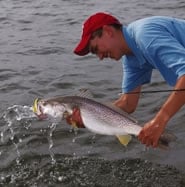
Even weakfish get in on the act, as juvenile menhaden provide forage for many predatory species during late summer and fall.|
When you uncover a concentration of peanuts, approach them cautiously rather than plowing over the bait ball. That only forces them down and ruins your fishing, as well as that of any nearby anglers. Instead, jog upcurrent or upwind, cut the motor and drift back toward the school.
Many fishermen instinctively heave big surface plugs into the melee. But that is seldom productive because there are so many thousands of tiny baitfish in the school that their lures are either overlooked or rejected for being too large. One of the most effective – and seldom used – techniques is to work small diamond jigs below the schools.
“The best approach,” says Captain Kerry Douton, owner of the charter boat Dot-E-Dee in Waterford, Connecticut, “is to drop your jig to the bottom, retrieve it about ten quick turns and drop it back down again. Do that until you get a strike or drift away from the fish. Then reel in, move back ahead of the school and start again. Try to maintain a vertical drop and use the smallest jig possible given the wind, current and depth. Three- to four-ounce diamonds should be enough to easily reach bottom in most places in Long Island Sound, and they imitate the peanuts more closely.”
Lures worked off the bottom and on the edges of peanut schools will produce a variety of strikes. While bluefish and schoolie stripers are most common, you may also hook fluke or big weakfish. Later in August, false albacore and bonito will join the mix. But light diamond jigs aren’t the only effective bunker imitators.
“A leadhead rigged with an appropriate-sized soft-plastic body is deadly,” says Kittredge. “Many times a leadhead dropped deep brings up the big fish. It can be jigged vertically or cast and allowed to sink before being retrieved with a jerking motion. Keep the speed no faster than the speed at which the bait is swimming. If the lure moves too fast or too slow it will usually be ignored.”
Plastic and Metal
Rowney also uses soft-plastics, such as shad bodies, Storm Wildeyes and Fin-S-Fish rigged on 1/4- to 1/2-ounce jigheads. Other time he’ll cast 1/2 – to one-ounce metal lures such as Kastmasters, Crippled Herrings and Hopkins. “If you’re not hooking up,” he says, “try slowing your retrieve. A lonely, injured baitfish limping back to the school represents an easy meal to any hungry predator. When the fish have passed, resist the urge to fire up the motor and give chase. There is a good chance a lazy striper, weakfish or big fluke is picking up scraps near the bottom, so fish deeper and slower. If you get nothing, crank her up and move back to the surface action.”
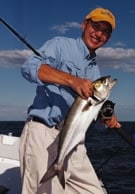
Diamond jigs do a great job of imitating an injured bunker, and will draw strikes from all the major game species when fished below the school.|
Lastly, small swimming plugs such as the Yo-Zuri Crystal Minnow, Rattlin’ Rapala or Rat-L-Trap can be productive when cast or trolled around the edges of the bunker schools. Be sure to try different retrieve and trolling speeds before moving on to another school.
Rigging Up
For diamond-jigging, I use a medium-action rod matched to a medium levelwind reel, such as a Penn 310 GTI or Shakespeare TWMA30L, which I spool with 20- to 30-pound super braid. For a leader, I like three feet of 60- to 80-pound fluorocarbon. For casting soft-plastics, Kittredge uses a light-to moderate-action rod, such as a Shakespeare Ugly Stick Custom model USCS 1170M, matched to spinning a reel such as a Shakespeare Tidewater 5450 or Penn 5500. He spools up with 17-pound backing and adds a top shot of 125 to 175 yards of 15-pound super braid, followed by 18 inches of 20-pound knottable wire leader. The wire doesn’t seem to reduce the number of hits from stripers, but sure saves on tackle if bluefish are in the area.
On the hot August day described earlier, Al and I would have lost a small fortune in lures if we hadn’t used wire. But we did, and ended up catching 30 bluefish before the current and the action waned. But the disappearance of the blues gave other predators a chance to find our lures, and we boated two weakfish, one keeper fluke and five schoolie bass before the tide quit altogether.
“Want to head for the barn?” I asked Al as we stowed the rods.
“Sounds like a plan,” he said. “It doesn’t get much better than that mixed bag.”
“Yeah,” I said. “I can’t wait to do it again tomorrow!”
| ### AREA INFORMATION#### Rhode Island * Rhode Island Tourism Division (800) 556-2484 or (401) 423-1941 * Rhode Island Dept of Fisheries and Wildlife (401) 789-3094 www.state.ri.us/dem/ ¿#### Southern Massachusetts * Massachusetts Division of Marine Fisheries (617) 626-1520 www.state.ma.us/dfwele/ * Massachusetts Office of Travel and Tourism (800) 447-6277 www.massvacation.com * Massachusetts Public Access Guide (617) 727-1843 ¿#### Area Light-Tackle Guides * Capt. Dixon Merkt eastern Connecticut (860) 227-3616 * Capt. Kerry Douton eastern Connecticut (860) 739-7419 * Capt. Pete Rowney Rhode Island (781) 447-5495 * Capt. Dave Sanderson Rhode Island (781) 864-5479 * Capt. Hal Herrick Nantucket, Massachusetts (508) 257-9606 * Capt. Ned Kittredge southern Massachusetts (508) 998-7965 |









